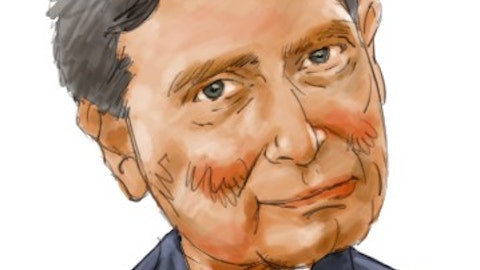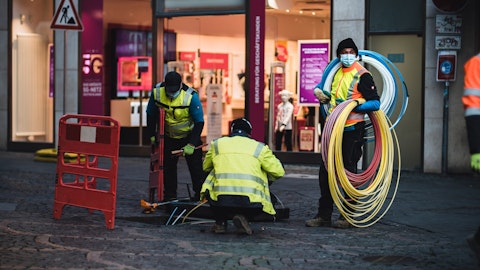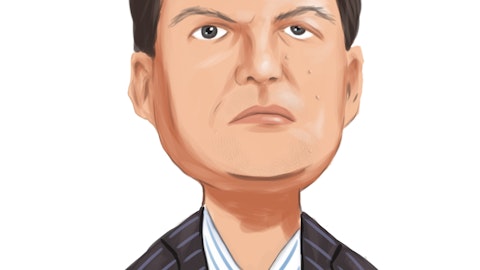Jessica Fischer: Sure. Thanks, Craig. So I’m going to start on the wireless side, and then I’ll come back and hit the Internet side. On the wireless side, our rate of net additions, it’s been not perfectly steady, but fairly steady over the last four quarters now, with Spectrum One in place. And so as you lap and have the roll-off of those free lines that were in the fourth quarter of last year, and you create new free lines in the fourth quarter of this year, what I would say is that the impact that the free lines have on overall ARPU, it ceases to become a pressure on ARPU. And as the free lines as a portion make up a smaller and smaller percentage of the total lines, over time, because the base is growing underneath them and the number of free lines sort of stabilizes, I think that you do have a little bit of remaining — or you could have a little bit of positive pressure on ARPU.
The other side of that, we do still have some legacy pricing in the mix that has to roll off. So probably on wireless, more stabilized next year. If you think about what the impact is that it’s having on Internet, so Internet ARPU growth, if you sort of look at it at a product ARPU level, gap growth in the year-over-year was 2.6%. Without the Spectrum One mobile allocation in there, it would have been 3.7%. So you have about a 1.1% difference in product line ARPU growth that relates to that allocation from the fee line. As those free lines start to roll off, I think actually, the dynamic is the same. The total free lines in the system become sort of steady in the year-over-year. So that mobile allocation becomes steady as you get into Q4. So, there is the potential then that what you see from a GAAP reporting perspective is better ARPU growth on the sort of Internet component, but it’s related to just not having the building of that GAAP allocation inside of the Internet product.
Craig Moffett: That’s helpful. Thank you.
Stefan Anninger: Thanks, Craig. We will go take our next question, please.
Operator: Our next question comes from Ben Swinburne with Morgan Stanley. You may ask your question.
Ben Swinburne: Thank you. Good morning, everyone. I’m hoping you could spend a little more time talking about the CapEx outlook and strategy around sort of three buckets: the digital evolution, the line extensions and then Xumo or, I guess, video. It sounds like we should continue to assume about $5.5 billion for the network evolution spend, but it sounds like the timing of that may have moved, maybe some — maybe less more this year, but less next couple of years, and then more maybe in 2026. I wonder if you could help us there. Is there a change in the $4 billion a year of line extensions from the higher RDOF opportunity that you talked about? And then I don’t think you’ve been spending much at all, I would guess, on video CPE, given recycling of set-tops, et cetera.
So, can you fill us in a little bit on the Xumo plan? Because I’m trying to think about whether you’re sort of going to be slowly moving your video sub base over time to a whole new equipment fleet, so to speak, and trying to understand what that might look like from a CapEx point of view. So I know that’s a lot, but you guys give us a lot to chew on, but I’d ask for some help.
Chris Winfrey: It was our fault, Ben. That’s true. Why don’t I take two of those, being network evolution — or start off with two of those network evolution video CPE, and let Jessica take expansion and any gaps that I missed on the first two. On network evolution, we — I mentioned that we could potentially slow down by, call it, six months. And then the counter to that, obviously, is wait a second, I thought this is improving your competitive standpoint, it is. But I would flag that we’re competing. One, it’s not that material at a time difference. And two, we’re competing well against fiber today. And our goal remains to have a superior speed claims across everywhere we operate in our footprint. That being said, we’ve always said that we’ll accelerate investments wherever we can.
And the trade-off to that is we also recognize there is value in showing some discipline to shareholders in terms of the overall envelope capital and these rural investments, which continue to expand both in terms of size and our capabilities to deploy quickly. They produce immediate gains. So when you step back and think about trying to balance both our traditional approach, which is if there’s capital returns, capital that can be deployed that has great ROI go as fast as you can, at the same time, balance investor expectations and show discipline there in terms of the overall envelope, a six-month time line, it’s not going to make that much difference long-term. There is an additional benefit operationally, which is that an extended time line allows some of our DAA or distributed access architecture suppliers to catch up with the latest technology at full scale so that we can deploy the most advanced gear as part of this wave of high split and DOCSIS — eventually DOCSIS 4.0 implementation.
So, that’s my thoughts on network evolution. Jessica can come back in a second and clean up on that, if I missed something. On video CPE, it’s — we have, over time, spent less on video CPE because we’ve been able to recycle World Box at the initial beginning of deployment for Xumo, we needed to get a starting state inventory of Xumo Boxes, and that’s captured in capital. On the increment, we will be deploying more new boxes than we have in the past because we’re essentially using Xumo as our go-to-market deployment for video CPE, and that’s going very well right now. And — now the boxes are less expensive than what traditional boxes have been over the past, and we expect the cost of those boxes to continue to decline significantly. So, you’ll have a combination of volume, which will be determined by our success, and a lower price point over time as well as lower need to build up inventory through all of our channels and throughout the country.
So it’s — there’s a step-up there. But long term, I don’t expect it to be that material.





